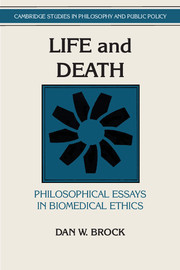Book contents
- Frontmatter
- Contents
- Sources and acknowledgments
- Introduction
- PART I PHYSICIANS AND PATIENTS MAKING TREATMENT DECISIONS
- PART II LIFE-AND-DEATH DECISIONS IN THE CLINIC
- 4 Moral rights and permissible killing
- 5 Taking human life
- 6 Death and dying
- 7 Forgoing life-sustaining food and water: Is it killing?
- 8 Voluntary active euthanasia
- PART III LIFE-AND-DEATH DECISIONS IN HEALTH POLICY
- Index
6 - Death and dying
Published online by Cambridge University Press: 05 June 2012
- Frontmatter
- Contents
- Sources and acknowledgments
- Introduction
- PART I PHYSICIANS AND PATIENTS MAKING TREATMENT DECISIONS
- PART II LIFE-AND-DEATH DECISIONS IN THE CLINIC
- 4 Moral rights and permissible killing
- 5 Taking human life
- 6 Death and dying
- 7 Forgoing life-sustaining food and water: Is it killing?
- 8 Voluntary active euthanasia
- PART III LIFE-AND-DEATH DECISIONS IN HEALTH POLICY
- Index
Summary
In recent decades medicine has gained dramatic new abilities to prolong life. Patients with kidney failure can be placed on renal dialysis; patients who have suffered cardiac arrest can sometimes be revived with advanced life-support measures including drugs, electric shock, airway intubation and closed or open heart massage; patients with pulmonary disease can be assisted by mechanical ventilation on respirators; and patients unable to eat or drink can receive nourishment and fluids intravenously or with tube feedings. These are only some of the most dramatic and well-known additions to medicine's armamentarium for staving off death in the gravely ill. While these and other life-sustaining treatments often provide very great benefits to individual patients by restoring or prolonging functioning lives, they also have the capacity to prolong patients' lives beyond the point at which they desire continued life support or are reasonably thought to be benefitted by it. Thus, where once nature took its course and pneumonia was the “old man's friend,” now increasingly someone must decide how long a life will be prolonged and when death will come. This chapter addresses some of the principal moral issues and arguments in current debates about life support. First, I address very briefly a related issue: the definition of death.
- Type
- Chapter
- Information
- Life and DeathPhilosophical Essays in Biomedical Ethics, pp. 144 - 183Publisher: Cambridge University PressPrint publication year: 1993



